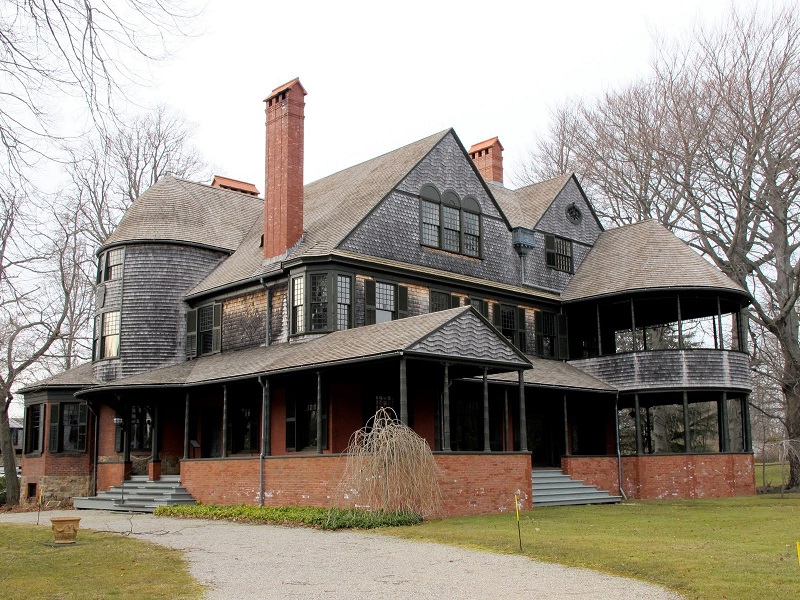Shingle style architecture
The Shingle style was employed between 1880 and 1900 by prominent American architects like H.H. Richardson, Frank Lloyd Wright and the firm of McKim, Meade, and White. The Shingle style is sometimes referred to as an outgrowth of the Queen Anne style as influenced by the early shingled buildings of New England colonies.
The style began in the New England region and some of the earliest and most notable examples are located there. The Shingle style spread throughout the country, but never became as popular or prevalent as the Queen Anne style. It remained a high fashion, architect-designed style that was seldom translated into more vernacular housing use.
The Shingle style house is marked by the presence of shingles on not just the roof, but on the wall surfaces themselves. The first floor walls may be shingled, or of stone or brick. Shingles may also cover gable ends, curving towers and porch columns.
Shingle style buildings have a rather monochrome appearance since the shingles are unpainted and uniformly cover most exterior surfaces. In shape and form, the Shingle style resembles the Queen Anne style, but it lacks the abundant decorative details. Porches are expansive, often wrapping around the front and sides of the building. Roofs are generally sweeping and multi-gabled. Windows are small and multi-paned and are often grouped in pairs or triples.
The most identifiable features of shingle style architecture include:
- Shingled walls and roof.
- Asymmetrical façade.
- Irregular roof lines.
- Moderately pitched roofs.
- Cross gables.
- Extensive wide porches.
- Small sash or casement windows with many panes.
- Round or polygonal shingled towers.
This article was written by PHMC.
--Pennsylvania Historical and Museum Commission
See also: Shingle roofing.
NB The 2018 International Residential Code (IRC), published by the International Code Council (ICC) defines shingle fashion as: ‘A method of installing roof or wall coverings, water-resistive barriers, flashing or other building components such that upper layers of material are placed overlapping lower layers of material to provide drainage and protect against water intrusion at unsealed penetrations and joints or in combination with sealed joints.’
[edit] Related articles on Designing Buildings Wiki
- Architectural styles.
- Arts and craft movement.
- Balloon framing.
- Beaux Arts style.
- Bungalow.
- Chateauesque style.
- Classical Revival style.
- Frank Lloyd Wright.
- Nineteenth century architecture.
- Octagon style.
- Prairie School style.
- Rule of thumb.
- Shingle roofing.
- Spanish Colonial revival style.
- Stick style.
- Tudor Revival style.
Featured articles and news
The UK’s largest air pollution campaign.
Future Homes Standard, now includes solar, but what else?
Will the new standard, due to in the Autumn, go far enough in terms of performance ?
BSRIA Briefing: Cleaner Air, Better tomorrow
A look back at issues relating to inside and outside air quality, discussed during the BSRIA briefing in 2023.
Restoring Abbotsford's hothouse
Bringing the writer Walter Scott's garden to life.
Reflections on the spending review with CIAT.
Retired firefighter cycles world to raise Grenfell funds
Leaving on 14 June 2025 Stephen will raise money for youth and schools through the Grenfell Foundation.
Key points for construction at a glance with industry reactions.
Functionality, visibility and sustainability
The simpler approach to specification.
Architects, architecture, buildings, and inspiration in film
The close ties between makers and the movies, with our long list of suggested viewing.
SELECT three-point plan for action issued to MSPs
Call for Scottish regulation, green skills and recognition of electrotechnical industry as part of a manifesto for Scottish Parliamentary elections.
UCEM becomes the University of the Built Environment
Major milestone in its 106-year history, follows recent merger with London School of Architecture (LSE).
Professional practical experience for Architects in training
The long process to transform the nature of education and professional practical experience in the Architecture profession following recent reports.
A people-first approach to retrofit
Moving away from the destructive paradigm of fabric-first.
International Electrician Day, 10 June 2025
Celebrating the role of electrical engineers from André-Marie Amperè, today and for the future.
New guide for clients launched at Houses of Parliament
'There has never been a more important time for clients to step up and ...ask the right questions'
The impact of recycled slate tiles
Innovation across the decades.
EPC changes for existing buildings
Changes and their context as the new RdSAP methodology comes into use from 15 June.

























